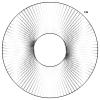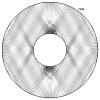The Earth, modeled with three segments, a solid inner core (IC), liquid outer core (OC) and solid mantle (MT), each axisymmetric and flattened along the shared mean axis of rotation, is known to have four principal free modes involving wobble/nutation: two modes which are primarily long-period prograde motions in the terrestrial reference frame, the Chandler wobble (CW) and inner core wobble (ICW), and two modes which are primarily long-period oscillations in inertial space, the retrograde free core nutation (FCN) and the prograde free inner core nutation (FICN). The terms ’prograde’ and ’retrograde’ describe the motion of the rotation pole (whether as wobble about its mean position in the terrestrial reference frame, or as nutation about its mean position in inertial space) as being respectively the same as, or opposite to, the sense of the axial rotation itself. The CW, discovered by Chandler in 1891, is the Eulerian wobble predicted for a rigid Earth model, with period lengthened from 306 to 435 sidereal days (sd) due to the combined effects of MT elasticity and the presence of the oceans and the OC. The FCN, formerly often called the nearly diurnal free wobble (NDFW), was first modeled by Hough (1895) and Sloudsky (1895) independently, and is due to the existence of the liquid OC. Its period, determined both from very-long-baseline interferometry (VLBI) and superconducting gravimetry, is 429 sd, some 25-30 sd shorter than computed using a hydrostatic Earth model.
I, in collaboration with Prof. Michael Rochester of Memorial University, have recently developed a new description of the linearized dynamics of planetary fluid cores. I have also developed new computational methods and efficient algorithms to implement the new description and predict the periods of the long-period free oscillations of planetary and stellar fluid bodies. Since the Earth's deep interior is not directly accessible, detecting and identifying the Earth's oscillations is one of very limited number of ways to gain insight into the Earth's deep interiors and improve our knowledge of its properties and orientation.
Move the cursor on the image for a short description of it.




